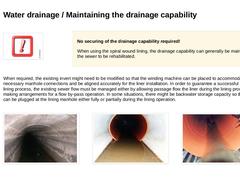
|
No securing of the drainage capability required! When using the spiral wound lining, the drainage capability can generally be maintained in the sewer to be rehabilitated. When required, the existing invert might need to be modified so that the winding machine can be placed to accommodate the necessary manhole connections and be aligned accurately for the liner installation. In order to guarantee a successful spiral wound lining process, … |
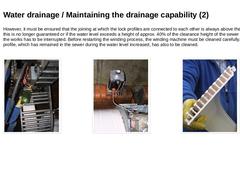
|
However, it must be ensured that the joining at which the lock profiles are connected to each other is always above the water level. If this is no longer guaranteed or if the water level exceeds a height of approx. 40% of the clearance height of the sewer cross section, the works has to be interrupted. Before restarting the winding process, the winding machine must be cleaned carefully. The plastics profile, which has remained in the sewer during … |
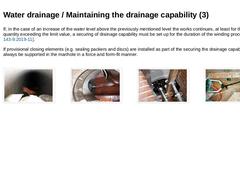
|
If, in the case of an increase of the water level above the previously mentioned level the works continues, at least for the drainage quantity exceeding the limit value, a securing of drainage capability must be set up for the duration of the winding process [DWA-M 143-9:2019-11]. If provisional closing elements (e.g. sealing packers and discs) are installed as part of the securing the drainage capability, they must always be supported in the manhole … |
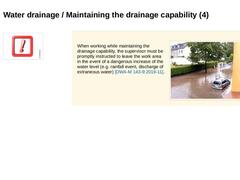
|
When working while maintaining the drainage capability, the supervisor must be promptly instructed to leave the work area in the event of a dangerous increase of the water level (e.g. rainfall event, discharge of extraneous water) [DWA-M 143-9:2019-11]. (Image: Flooding of a road section) |
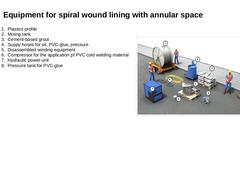
|
-
Plastics profile
-
Mixing tank
-
Cement-based grout
-
Suppy hoses for oil, PVC-glue, pressure
-
Disassembled winding equipment
-
Compressor for the application pf PVC cold welding material
-
Hydraulic power unit
-
Pressure tank for PVC-glue
(Image: Equipment for spiral wound lining with annular space) |
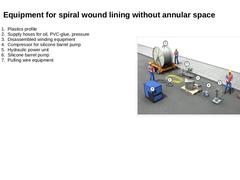
|
-
Plastics profile
-
Supply hoses for oil, PVC-glue, pressure
-
Disassembled winding equipment
-
Compressor for silicone barrel pump
-
Hydraulic power unit
-
Silicone barrel pump
-
Pulling wire equipment
(Image: Equipment for spiral wound lining without annular space) |
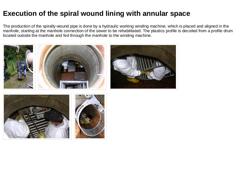
|
The production of the spirally-wound pipe is done by a hydraulic working winding machine, which is placed and aligned in the manhole, starting at the manhole connection of the sewer to be rehabilitated. The plastics profile is decoiled from a profile drum located outside the manhole and fed through the manhole to the winding machine. (Image: Lowering the machine drive into the starting manhole) (Image: Assembly of the winding basket in the starting … |
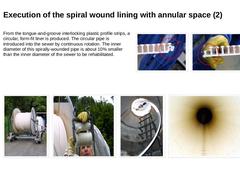
|
From the tongue-and-groove interlocking plastic profile strips, a circular, form-fit liner is produced. The circular pipe is introduced into the sewer by continuous rotation. The inner diameter of this spirally-wounded pipe is about 10% smaller than the inner diameter of the sewer to be rehabilitated. (Image: Plastics profile (PVC-profile) - Detailed view of groove) (Image: Plastics profile (PVC-profile) - Detailed view of tongu) (Image: Delivery … |
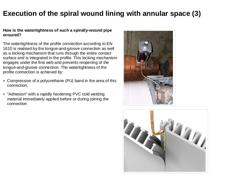
|
How is the watertightness of such a spirally-wound pipe ensured? The watertightness of the profile connection according to EN 1610 is realised by the tongue-and-groove connection as well as a locking mechanism that runs through the entire contact surface and is integrated in the profile. This locking mechanism engages under the first web and prevents reopening of the tongue-and-groove connection. The watertightness of the profile connection is achieved … |
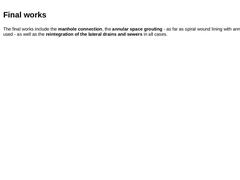
|
The final works include the manhole connection, the annular space grouting - as far as spiral wound lining with annular space is used - as well as the reintegration of the lateral drains and sewers in all cases. |
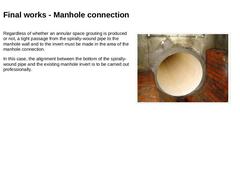
|
Regardless of whether an annular space grouting is produced or not, a tight passage from the spirally-wound pipe to the manhole wall and to the invert must be made in the area of the manhole connection. In this case, the alignment between the bottom of the spirally-wound pipe and the existing manhole invert is to be carried out professionally. (Image: Manhole connection) |
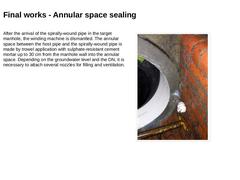
|
|
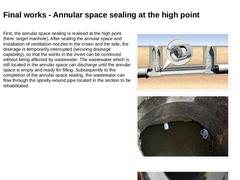
|
First, the annular space sealing is realised at the high point (here: target manhole). After sealing the annular space and installation of ventilation nozzles in the crown and the side, the drainage is temporarily interrupted (securing drainage capability), so that the works in the invert can be continued without being affected by wastewater. The wastewater which is still located in the annular space can discharge until the annular space is empty … |
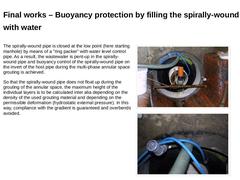
|
The spirally-wound pipe is closed at the low point (here starting manhole) by means of a "ring packer" with water level control pipe. As a result, the wastewater is pent-up in the spirally-wound pipe and buoyancy control of the spirally-wound pipe on the invert of the host pipe during the multi-phase annular space grouting is achieved. So that the spirally-wound pipe does not float up during the grouting of the annular space, the maximum height of … |
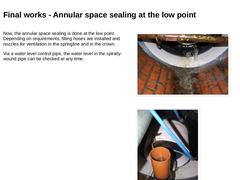
|
Now, the annular space sealing is done at the low point. Depending on requirements, filling hoses are installed and nozzles for ventilation in the springline and in the crown. Via a water level control pipe, the water level in the spirally-wound pipe can be checked at any time. (Image: Discharging wastewater through the ring packer/spirally-wound pipe construction) (Image: Water level control pipe for generating and controlling the required water pressure … |
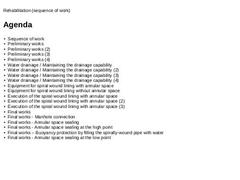
|
|
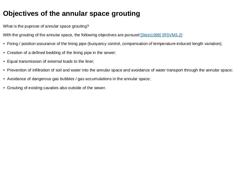
|
What is the puprose of annular space grouting? With the grouting of the annular space, the following objectives are pursued [Stein1998] [RSVM3.2]: -
Fixing / position assurance of the lining pipe (buoyancy control, compensation of temperature-induced length variation);
-
Creation of a defined bedding of the lining pipe in the sewer;
-
Equal transmission of external loads to the liner;
-
Prevention of infiltration of soil and water into the annular space …
|
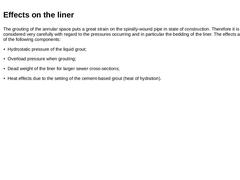
|
The grouting of the annular space puts a great strain on the spirally-wound pipe in state of construction. Therefore it is to be considered very carefully with regard to the pressures occurring and in particular the bedding of the liner. The effects are composed of the following components: -
Hydrostatic pressure of the liquid grout;
-
Overload pressure when grouting;
-
Dead weight of the liner for larger sewer cross-sections;
-
Heat effects due to the …
|
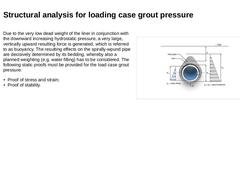
|
Due to the very low dead weight of the liner in conjunction with the downward increasing hydrostatic pressure, a very large, vertically upward resulting force is generated, which is referred to as buoyancy. The resulting effects on the spirally-wpund pipe are decisively determined by its bedding, whereby also a planned weighting (e.g. water filling) has to be considered. The following static proofs must be provided for the load case grout pressure: |
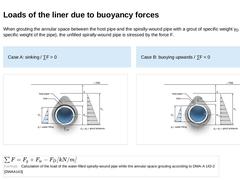
|
When grouting the annular space between the host pipe and the spirally-wound pipe with a grout of specific weight γD > γR (γR = specific weight of the pipe), the unfilled spirally-wound pipe is stressed by the force F. (Image: Loading situation when filling the annular gap (superelevated display) for the case A (sinking) and loading case I (line bearing) in accordance with DWA-A 143-2) Case B: buoying upwards / ∑F < 0 (Image: … |
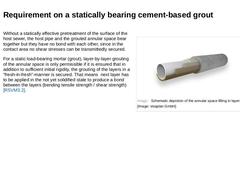
|
|
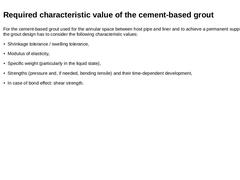
|
For the cement-based grout used for the annular space between host pipe and liner and to achieve a permanent support of the liner, the grout design has to consider the following characteristic values: -
Shrinkage tolerance / swelling tolerance,
-
Modulus of elasticity,
-
Specific weight (particularly in the liquid state),
-
Strengths (pressure and, if needed, bending tensile) and their time-dependent development,
-
In case of bond effect: shear strength.
|
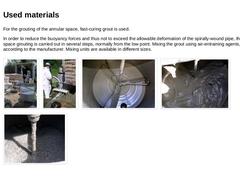
|
For the grouting of the annular space, fast-curing grout is used. In order to reduce the buoyancy forces and thus not to exceed the allowable deformation of the spirally-wound pipe, the annular space grouting is carried out in several steps, normally from the low point. Mixing the grout using air-entraining agents, is carried out according to the manufacturer. Mixing units are available in different sizes. (Image: Installation of the mixing unit at … |
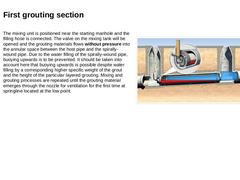
|
The mixing unit is positioned near the starting manhole and the filling hose is connected. The valve on the mixing tank will be opened and the grouting materials flows without pressure into the annular space between the host pipe and the spirally-wound pipe. Due to the water filling of the spirally-wound pipe, buoying upwards is to be prevented. It should be taken into account here that buoying upwards is possible despite water filling by a corresponding … |
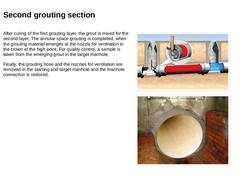
|
After curing the first grouting layer, the grout is to be mixed for the second layer. The annular space grouting is completed when the grouting material emerges at the nozzle for ventilation in the crown at the high point. For quality control, a sample is taken from the emerging grout in the target manhole. Finally, the grouting hose and the nozzles for ventilation shall be removed in the starting and target manhole and the manhole connection is restored. |